

Category of being. Categorical distinctions[edit] The common or dominant ways to view categories as of the end of the 20th century. via bundle theory as bundles of properties – categories reflect differences in thesevia peer-to-peer comparisons or dialectics – categories are formed by conflict/debatevia value theory as leading to specific ends – categories are formed by choosing endsvia conceptual metaphors as arising from characteristics of human cognition itself – categories are found via cognitive science and other study of that biological system Any of these ways can be criticized for...
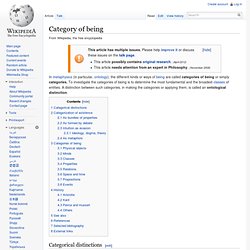
In process philosophy, this last is the only possibility, but historically philosophers have been loath to conclude that nothing exists but process. Www.math.ucla.edu/~mburgin/papers/FstrSUM4.pdf. Systems theory. Systems theory is the interdisciplinary study of systems in general, with the goal of elucidating principles that can be applied to all types of systems at all nesting levels in all fields of research.
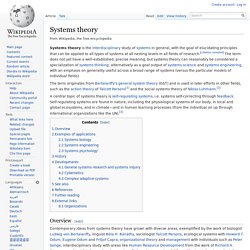
[citation needed] The term does not yet have a well-established, precise meaning, but systems theory can reasonably be considered a specialization of systems thinking; alternatively as a goal output of systems science and systems engineering, with an emphasis on generality useful across a broad range of systems (versus the particular models of individual fields). A central topic of systems theory is self-regulating systems, i.e. systems self-correcting through feedback. Self-regulating systems are found in nature, including the physiological systems of our body, in local and global ecosystems, and in climate—and in human learning processes (from the individual on up through international organizations like the UN).[3] Ousia. Philosophical and scientific use[edit] Theological significance[edit] New Testament[edit]
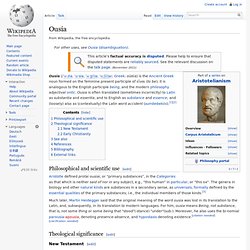
Bootstrapping. In general parlance, bootstrapping usually refers to the starting of a self-sustaining process that is supposed to proceed without external input.

In computer technology the term (usually shortened to booting) usually refers to the process of loading the basic software into the memory of a computer after power-on or general reset, especially the operating system which will then take care of loading other software as needed. The term appears to have originated in the early 19th century United States (particularly in the phrase "pull oneself over a fence by one's bootstraps"), to mean an absurdly impossible action, an adynaton.[1][2][3] Etymology[edit] A pair of boots with one bootstrap visible Tall boots may have a tab, loop or handle at the top known as a bootstrap, allowing one to use fingers or a boot hook tool to help pulling the boots on. Applications[edit] Computing[edit] Software loading and execution[edit] World line. In physics, the world line of an object is the unique path of that object as it travels through 4-dimensional spacetime.
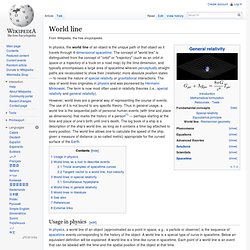
The concept of "world line" is distinguished from the concept of "orbit" or "trajectory" (such as an orbit in space or a trajectory of a truck on a road map) by the time dimension, and typically encompasses a large area of spacetime wherein perceptually straight paths are recalculated to show their (relatively) more absolute position states — to reveal the nature of special relativity or gravitational interactions. The idea of world lines originates in physics and was pioneered by Hermann Minkowski. The term is now most often used in relativity theories (i.e., special relativity and general relativity).
Bootstrap paradox. The bootstrap paradox, or ontological paradox, is a paradox of time travel that refers to scenarios whereby items or information are passed from the future to the past, which in turn become the same items or information that are subsequently passed from the past to the future - this creates a circularity of cause-effect such that the items or information have no discernible origin.
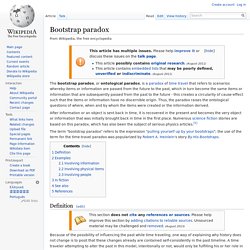
Thus, the paradox raises the ontological questions of where, when and by whom the items were created or the information derived. After information or an object is sent back in time, it is recovered in the present and becomes the very object or information that was initially brought back in time in the first place. Numerous science fiction stories are based on this paradox, which has also been the subject of serious physics articles.[1] Ontic. In philosophy, ontic (from the Greek ὄν, genitive ὄντος: "of that which is") is physical, real, or factual existence.
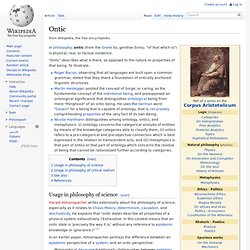
"Ontic" describes what is there, as opposed to the nature or properties of that being. To illustrate: Usage in philosophy of science[edit] Harald Atmanspacher writes extensively about the philosophy of science, especially as it relates to Chaos theory, determinism, causation, and stochasticity. He explains that "ontic states describe all properties of a physical system exhaustively. In an earlier paper, Atmanspacher portrays the difference between an epistemic perspective of a system, and an ontic perspective: Philosophical discourse traditionally distinguishes between ontology and epistemology and generally enforces this distinction by keeping the two subject areas separated. Pluralism (philosophy) Pluralism is a term used in philosophy, meaning "doctrine of multiplicity", often used in opposition to monism ("doctrine of unity") and dualism ("doctrine of duality").
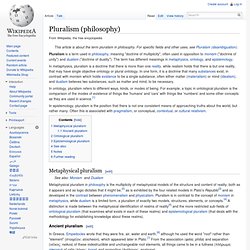
The term has different meanings in metaphysics, ontology, and epistemology. Substance theory. Ancient Greek philosophy[edit] A substance—that which is called a substance most strictly, primarily, and most of all—is that which is neither said of a subject nor in a subject, e.g. the individual man or the individual horse.
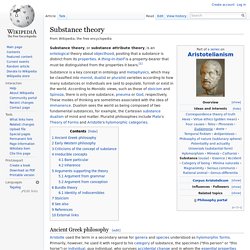
The species in which the things primarily called substances are, are called secondary substances, as also are the genera of these species. For example, the individual man belongs in a species, man, and animal is a genus of the species; so these—both man and animal—are called secondary substances.[2]—Aristotle, Categories 2a13, (trans. J.L. Ackrill) Neither the "bare particulars" nor "property bundles" of modern theory have their antecedent in Aristotle, according to whom, all matter exists in some form. Philosophy of mathematics. The philosophy of mathematics is the branch of philosophy that studies the philosophical assumptions, foundations, and implications of mathematics.
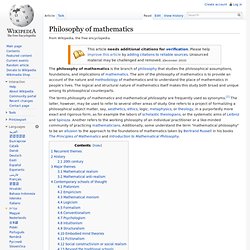
The aim of the philosophy of mathematics is to provide an account of the nature and methodology of mathematics and to understand the place of mathematics in people's lives. The logical and structural nature of mathematics itself makes this study both broad and unique among its philosophical counterparts. The terms philosophy of mathematics and mathematical philosophy are frequently used as synonyms.[1] The latter, however, may be used to refer to several other areas of study.
Mereology. Mereology has been axiomatized in various ways as applications of predicate logic to formal ontology, of which mereology is an important part. A common element of such axiomatizations is the assumption, shared with inclusion, that the part-whole relation orders its universe, meaning that everything is a part of itself (reflexivity), that a part of a part of a whole is itself a part of that whole (transitivity), and that two distinct entities cannot each be a part of the other (antisymmetry).
A variant of this axiomatization denies that anything is ever part of itself (irreflexive) while accepting transitivity, from which antisymmetry follows automatically. Standard university texts on logic and mathematics are silent about mereology, which has undoubtedly contributed to its obscurity. History[edit] A.N. In 1930, Henry Leonard completed a Harvard Ph.D. dissertation in philosophy, setting out a formal theory of the part-whole relation. Axioms and primitive notions[edit]
Gunk (mereology) In mereology, an area of philosophical logic, the term gunk applies to any whole whose parts all have further proper parts. That is, a gunky object is not made of indivisible atoms: If something is made of atomless gunk then it divides forever into smaller and smaller parts—it is infinitely divisible. However, a line segment is infinitely divisible, and yet has atomic parts: the points. A hunk of gunk does not even have atomic parts ‘at infinity’; all parts of such an object have proper parts.[1] If point-sized objects are always simple, then a gunky object does not have any point-sized parts.
General formal ontology. Includes objects as well as processes and both are integrated into one coherent system,includes levels of reality,[2]is designed to support interoperability by principles of ontological mapping and reduction,contains several novel ontological modules, in particular, a module for functions and a module for roles, andis designed for applications, firstly in medical, biological, and biomedical areas, but also in the fields of economics and sociology. Taxonomic tree of GFO[edit] Basic taxonomic tree of the General Formal Ontology Categories[edit] The common property of all categories is that they can be predicated of an entity.
Conceptual structures are mental representations of entities or universals, and they exist in an agent's mind. Symbolic structures are signs which may be instantiated by tokens. Space and time[edit] Connected three-dimensional parts of space are called "topoids". Processes and objects[edit] Upper ontology. The seemingly conflicting use of metaphors implying a solid rigorous bottom-up "foundation" or a top-down imposition of somewhat arbitrary, and possibly political, decisions is no accident – the field is characterized by the usual mix of controversy, politics, competing approaches and academic rivalry.
Some upper ontologies have led to commercial products, causing a financial incentive to promote one ontology over the competing systems. Debates notwithstanding, it can be said that a very important part of each upper ontology can be considered as the computational implementation of natural philosophy, which itself is a more empirical method for investigating the topics within the philosophical discipline of physical ontology. Library classification systems predate these upper ontology systems. Though library classifications organize and categorize knowledge using general concepts that are the same across all knowledge domains, neither system is a replacement for the other.